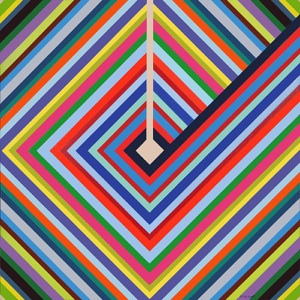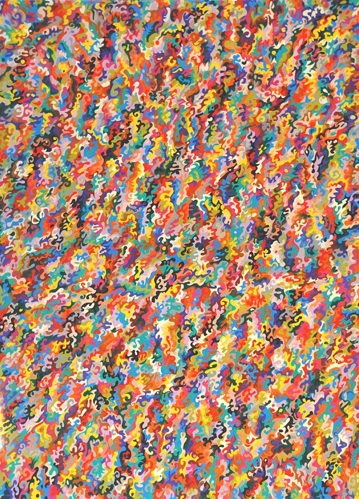
From art to Meta-art (3)
To get where she needs to go?
Where was it where she needed to go?
Actually she didn’t know.
The only thing she knew - from a very early age (4/5 years old...) already - was that painting and drawing were not taking her far enough to express what needed to be expressed to really embrace the magic of being...
In kindergarten already she tried to draw a picture in which the whole of the story of a number of characters was embraced. 4/5 years old she tried to draw the flow of time itself...
She didn’t succeed. But the attempt was already there: to express the interrelations between Everything.
EVERYTHING?
Nothing less. Rather even more.
Ode to grey, oil on canvas, 1993
Meta-art...Transcending the limitations of painting by... painting.
Never in the history of the arts there has been a more nonsensical undertaking.
Alpha and omega in Meta-art is the paradox.
The ‘methods’ of Meta-art are paradoxical inside out and outside in.
The results of these ‘methods’ are paradoxical inside out and outside in.
Paintings that express more than paintings are able to express... Meta-paintings.
Nonsensical, indeed.
There will be more paintings in which the meta-artist visualizes what is actually happing in her Meta-paintings.
Outside rigid boundaries is one of the strongest of them.
The main idea seems to be that, no matter how rigid certain boundaries may be, in Meta-art they will be surpassed in a most natural of ways.
Mark this: the boundary loses nothing of its rigidity.
It is the grandesse of the energy in the background that simply cannot be hold back by the boundary.
The boundary where ‘ordinary’ painting (Picasso, Rothko, Bacon) has to stop.
Meta-painting is entirely beyond that.
Outside rigid boundaries, oil on canvas, 1999
That’s the way it is, oil on canvas, 1996
As expected, such an artistic expression of everything brings forth extremely complicated works of (Meta-)art.
‘Where its power lies, there is also its ‘weakness’...’
Actually, the Meta-paintings of Marianne Schuit are so tremendously complex, that it takes even a highly trained art connoiseur quite a lot of time to recognize even the beginnings of what is happening in these Meta-paintings.
But... paradoxically (!)... they also speak to us on a very primary level, touching our subconcious sensitivities profoundly.
Meta-paintings like Night watch and Atlantis, insanely complex as they may be, touch something deep inside of us, far away from the intellectualism necessary to see the myriad of layers of meaning presented to us by such Meta-paintings.
And in a way it seems these Meta-paintings are meant to speak to us on this level: from subconscious to subconscious.
Who is afraid of Marianne Schuit?, oil on canvas, 2007
Night watch, oil on canvas, 2011
In the mean time one Meta-painting after another is testifying of the incredible break-through in painting.
Seemingly ‘just’ paintings, these Meta-paintings bring together what in‘ordinary’ paintings could never be brought together.
They are extremely dynamic, but just as static.
They are utterly playful, but just as dead serious.
They are losing themselves in every which direction they can... and still they are immensely focused.
They are profoundly empathic and just as profoundly distant...
They are the human mind, not losing itself in a focus on certain aspects of being, but stretching itself out over everything that affects this mind, be it small, be it large.
They are the artistic answer to the findings on the human mind as they are presented by contemporary neurology.
The human mind works (w)holistically. Meta-art is (w)holistic.
Atlantis, oil on canvas, 2010

In the year Insight took art to Meta-art, Marianne Schuit paints another painting in which she visualizes what needs to be done to get where she needs to go.
In Ode to grey no circles, but a dynamically coloured geometric pattern. Straight from the heart of the pattern rises a nonsensical element to the top of the painting. As if it has nothing to do with the rest of the painting, this white skin coloured line follows its very own path.
As if it knows that it is not in the coloured pattern, where the most essential lies...
Wasn’t there someone already looking out of the painting in one of her early works?...





Meta-art is the hugest step in the arts ever.
It takes creativity way beyond the possibilities that seemed defined by the art of geniuses like Van Gogh, Picasso and Rothko.
Marianne Schuit may be called a Meta-genius, being a mind not confined to the boundaries even such geniuses like the above mentioned are confined to.
Meta-art is creativity really taken to the boundless possibilities of the human mind.
Meta-art is the first artistic expression capable of showing the mind-blowing complexity of the human mind within... the just as mind-blowing unity we find in this mind.
Every rule of painting is applicable to Meta-art and still... the results of applying these rules are finding itself on the other side of what is actually possible considering these rules...
One last word about the passion of Marianne Schuit. A word I hardly ever use, because it has lost almost all of its contents. If there is one artist her burning passion could be compared with, it will be Van Gogh. Both work from a boundless unselfish love for our world that cannot be shared with this world in another way than through a creative expression that leaves all limits behind. In the case of Van Gogh he stayed most expressively within the rules of figuration. Marianne Schuit has taken this love beyond that, but in fact she also has taken it beyond the rules of abstraction... getting ever so close to the truly boundless character of this all-embracing love itself...
If ever a creative expression has been close to what it expresses, bearing almost the same qualities, it is Meta-art...


